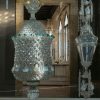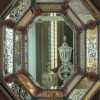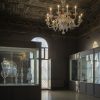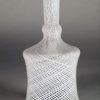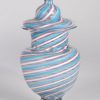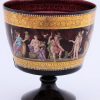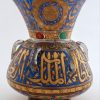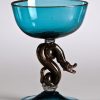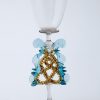The protagonists in this period were some master glassmakers and entrepreneurs who adopted various strategies in response to the crisis.
On the one hand, they accepted commissions from antique dealers to reproduce older models, whilst on the other, they managed to retrieve the secrets behind the making of certain types of glass which had fallen into disuse because of the very complexity of the procedures involved: as mentioned earlier, it was exactly in this period that Lorenzo Radi and Vincenzo Moretti were attending their researches on chalcedony and on murrine, repectively.
Filigree production was also rediscovered by the bead maker Domenico Bussolin, followed by Lorenzo Graziati and Pietro Bigaglia, who had already revived aventurine, at times using it in the lively polychromy of his thin cane filigrees. Of outstanding quality and technical perfection, with its simple, linear forms, their work reflected the Biedermeier style that was so fashionable in the mid nineteenth century.
However, it was not until the sixties that the Murano glass makers were to begin trying their hands at more increasingly complex works that were to testify their incredible skill; this applied to two glass furnaces in particular: F.lli Toso, who specialised in antique models, and Salviati & C., whose goods were destined for foreign markets, the British in particular; his beautiful, light, colourful and virtuoso glass, the likes of which had never been seen before, was displayed in exhibitions worldwide, meeting with unheard of success.
It was in this period that our museum opened and began its fruitful relationship with the glass furnaces, creating a school in its rooms to support their work. After almost a century of oblivion, Murano thus once again became a centre of artistic glass production. However, whilst of the most exquisite craftsmanship, at the end of the nineteenth century stylistically its models still looked towards the past, despite the fact that Art Nouveau had affirmed itself throughout Europe.
At the glass exhibition that was organised at the same time as the first Biennale in 1895, the only significant opening towards modernity was the outstanding spiral-stemmed cup by the Artisti Barovier Fornace.
